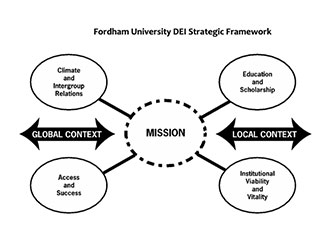Diversity, Equity, and Inclusion Strategic Framework
To be successful, we need to incorporate the complexity of diversity in such a way that the concept does not become watered down and generic. On the other hand, it needs to be inclusive. Here is our approach.
The Fordham Diversity, Equity, and Inclusion Strategic Framework draws on the work of higher education scholar Daryl Smith, which emphasizes four broad and interrelated dimensions. ( Smith, Darry. (2015). Diversity’s Promise for Higher Education: Making it Work. (2nd Ed.) Baltimore: Johns Hopkins University Press.)

Why this model?
- Mission centric
- Allows an institution, and its various components, to understand diversity in its own context
- Shifts the focus from groups to the institution
- Provides an understanding of what institutional capacity for diversity might look like
Institutional Viability and Vitality
Institutional Viability and Vitality focuses on certain key domains that build the institution’s capacity and structures for diversity.
Building capacity means developing the human and institutional resources and expertise to fulfill the institution’s mission internally, and to fulfill its mission to the broader society.
Does the institution have the people, resources, and expertise to fulfill its mission as it related to diversity?
**Alignment of rhetoric, activities, and institutional goals is extremely important in this dimension.
Access and Success refers (primarily) to the means students are admitted to the institution, and the institutional conditions that facilitate students’ success once they are enrolled.
- Focus on capacity building (resources, expertise, and talent) and infrastructure (physical, administrative, political, economic) for diversity, equity, and inclusion.
Key Components:
- Mission: Aligning diversity strongly with the institution’s mission is a cornerstone of this work. For Fordham, diversity will remain marginal unless it is central to the core teaching, research, and scholarly mission.
- Culture: Takes longer to change than climate, and must be framed so that diversity can be facilitated rather than obstructed.
- Human Capital: Do faculty, staff, and administration share a commitment to DEI goals? Do they possess the skills necessary implement DEI goals? If not, are there opportunities for them to be developed?
- Core Institutional Processes: To what degree is diversity engaged in strategic plans, ongoing reports to the board, accreditation documents, and strategic proposals?
- Perceptions of Institutional Commitment: Importance of people’s perceptions about fairness, overall views of the institution, or in specific domains such as the allocation of resources, procedures, and interpersonal treatment.
Access and Success
Access speaks to the compositional diversity of an institution, division or department
- Who comprises the community?
- Student Body
- Faculty
- Staff, administration, leadership
- Is there a critical mass of historically underrepresented students, faculty, staff, or is there a token presence?
- How is talent conceived and identified?
This dimension is the historical heart and soul of diversity work in higher education in the U.S., yet an area where most institutions still struggle.
Success involves markers of achievement, such as GPA, scholastic awards, leadership positions, academic major of concentration, years to degree completion, postgraduate success, and, of course, learning outcomes.
- Who is succeeding? Who is thriving?
- Are all groups of students engaged on campus?
- Where are they engaged?
- Do all groups perceive an institutional commitment to their success?
Disaggregating the key indicators that are being used ties diversity to education in a very central way.
Education and Scholarship
Education and Scholarship focuses on the academic core of the university, and specifically examines the educational experiences of all students, and the scholarly focus of the institution.
- What should that education look like in terms of the curriculum, pedagogy, faculty expertise, and so on?
- For schools such as Fordham, where research and graduate and professional education are central, this dimension brings attention to the production of new knowledge that addresses the intellectual and applied issues of the day.
- Does the university have the resources to give all students the experience of being educated to function effectively in a diverse society?
- Preparing students to be teachers, lawyers, doctors, etc., who can function in competent ways for their professions requires substantive engagement of diversity.
** Framing the diversity imperative in academic and educational terms is critically important for the engagement of faculty and for moving diversity conversations to the center of institutional concerns.
Climate and Intergroup Relations
Climate and Intergroup Relations focuses on the campus climate for students, faculty and staff, and the degree to which people are interacting across diverse groups.
It includes looking at the institution from a variety of perspectives, including not only those of race and ethnicity for historically underrepresented students, faculty, and staff, but the perspectives of all persons of color, women students, LGBTQ communities, religious minorities, and all other identity groups.
- How do individual students, faculty, and staff experience the university?
- What is universal about the Fordham experience?
- What makes people feel connected, affirmed, respected?
- To what degree do community members interact across differences?
- What is the qualitative nature of those interactions?
- What facilitates/hinders such interactions?
- Are there group differences in sense of belonging, trust, and/or feeling understood?
- How might these experiences impact retention, well-being and/or success?
** While intergroup relations could be included in the education and scholarship dimension (because of their relevance to classroom discussions and faculty capacity), they are included here as a broader institutional concern.
Interconnected, Inclusive, and Differentiated
Excellence in an institution, then, is defined by who succeeds, what is taught, and what research is thought to be important, who feels as if they matter, and whether the institution has sufficient resources of people, ideas, and policy to successfully function in a diverse context.